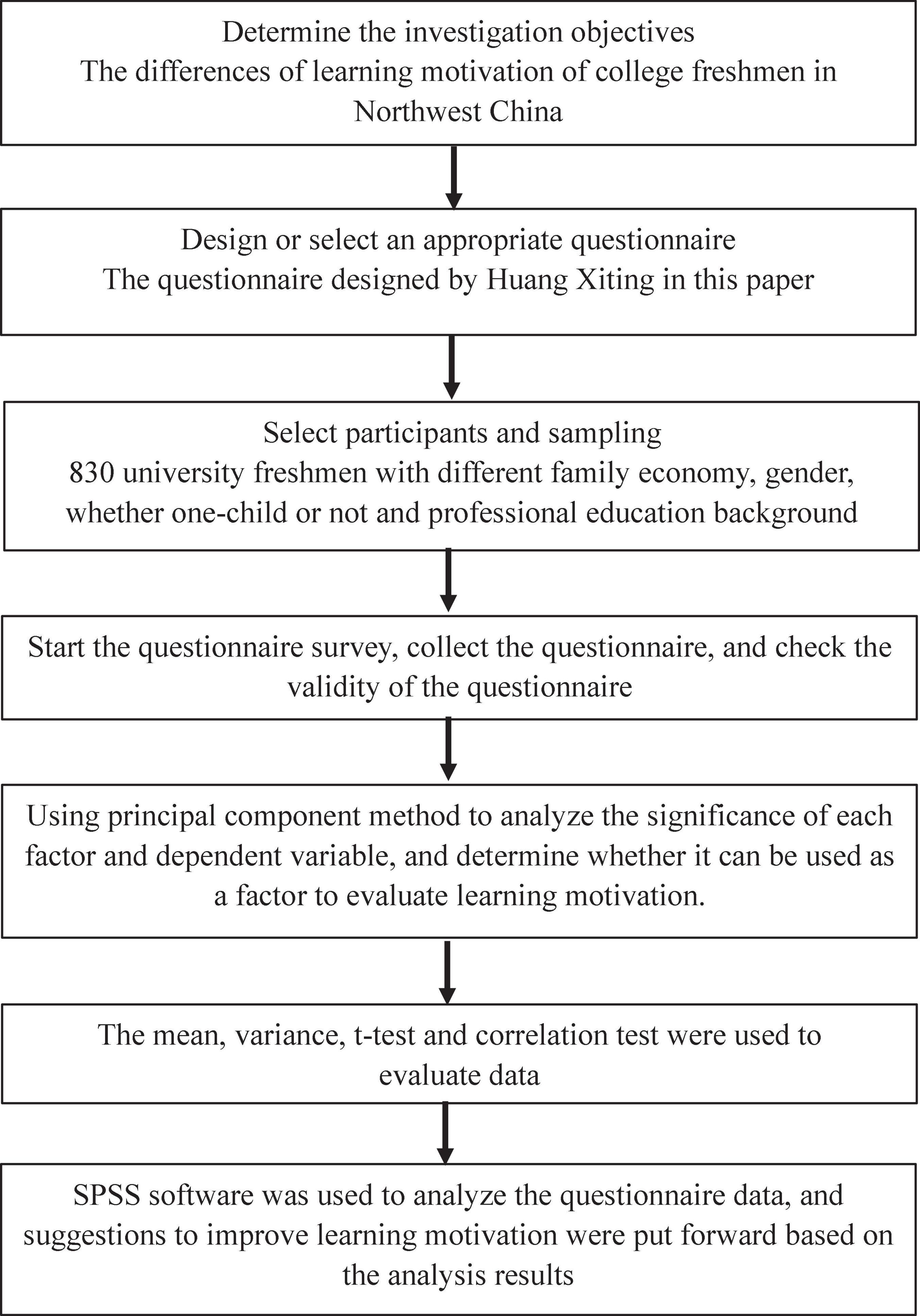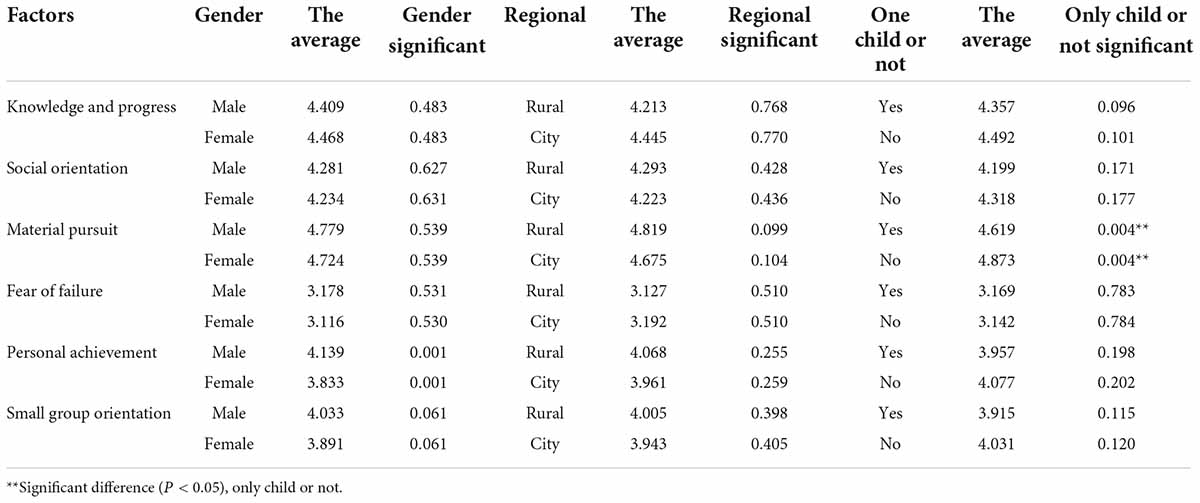- College of Metallurgical Engineering, Xi’an University of Architecture and Technology, Xi’an, China
The study aimed to investigate the learning motivation of freshmen from a university in Northwest China, which can supply a reference for improving their learning quality and objectives. Data were collected from 800 freshmen of different majors with a learning motivation questionnaire. Differences in learning motivation between different majors, genders, regions, and students are studied. The results show that gender, seeking knowledge orientation, and material pursuit have significant effects on students’ learning motivation. The gender had a significant impact on personal achievement and the only child or not had an obvious effect on material pursuit, while other factors had no obvious difference in gender, regional, and only child or not, while other factors on the gender, regional, and whether the one-child had no obvious difference. According to the results of the research, measures to improve learning motivation are proposed. Our research results provide a reference for improving learning attitude and the quality of universities.
Introduction
With the rapid development of China’s economy, the demand of social development for high-quality talents is increasing. Meanwhile, the educational resources are gradually enriched, which provides more learning opportunities for college students with more learning opportunities. In 2020, the number of Chinese college students exceeded 8.74 million (Liu et al., 2021). The learning quality of college students has become the focus of social concern, because college students are the main source of talents.
Learning motivation is a driving force for study and is the key factor that determines the quality of learning (Oudeyer et al., 2016; Chang et al., 2020). It is an important factor to motivate students to improve themselves academically and to affect their academic performance (Hu and McGeown, 2020). In order to improve the quality of training, colleges in China have paid more attention to helping students to form healthy learning motivation (Cao and Meng, 2020). Generally speaking, most students have a positive and healthy motivation, but some students have some problems such as addiction to social software or games to drop out, not caring about academic performance, and lack of confidence in learning.
According to Ryan and Deci (2002), motivations can be divided into intrinsic and extrinsic motivations. The intrinsic motivation is the motivation to participate in activities for the reason of the activity itself, but not for some external reward (Chang et al., 2020). The extrinsic motivation is the motivation to participate in activities as the way to achieve a certain goal, such as money, social advancement, friendship or avoid punishment, etc. (Tranquillo and Stecker, 2016). For students, especially freshmen in China, many factors have an effect on their learning motivations due to change in social environment with the development of the economy and technology. This will bring changes in their intrinsic and extrinsic motivations.
Meanwhile, family is the first environment for students (Octaviany and Usman, 2021), and improvement family socioeconomic status will make parents provide more funds for student’s study and opportunities. The only child in a Chinese family will enjoy more opportunities and financial support. Gobena (2018) said that family socio-economic status has an impact on students’ academic performance achievement at college of education and behavioral sciences. At the same time, both external and internal learning motivation will be changed compared with the university students in China’s backward economy, in especial before reform and opening up. Durdy et al.’s (2020) research suggests that the socioeconomic factor does not have a direct effect on learning outcome. However, Kormos and Kiddle’s (2013) research showed that the difference of family and social status has a significant impact on students’ learning motivation.
Besides, education background will also have an impact on students’ learning motivation (Qi and Zheng, 2010). For example, the training objectives of engineering students and art students from primary school to university are inconsistent, and they have differences in personal ideal pursuit, social orientation, and material pursuit. At the same time, gender is also a factor that cannot be ignored. For example, female students are more worried about failure and take learning more seriously (Chang et al., 2020).
In this article, university freshmen with different professional backgrounds were selected to analyze their learning motivations from the effects of family economy, gender, whether they are an only child or not, and professional education background, which will provide a reference for improving learning attitude and the quality of universities.
Participants and methods
The flow chart of this study is shown in Figure 1. The main research objective of this article is to study the differences in learning motivation of college freshmen in Northwest China by questionnaire survey. The participants and the sampling, learning motivation questionnaire, and statistical methods are shown as follows.
Participants and sampling
The participants were chosen from freshmen studying various majors in different colleges in Shaanxi province in China and had a total of 830. A total of 796 valid questionnaires were collected, with a valid response rate of 95.9%.
Learning motivation questionnaire
The questionnaire designed by Huang and Zheng (1999) is used to evaluate college students’ learning motivation. According to the survey on the demand structure of Chinese college students by Huang et al., the needs of college students can be divided into six basic types: physiological, safety, communication, respect, development, and contribution. Based on the embodiment of the six needs in learning motivation, 28 kinds of learning motivation are listed and randomly arranged. The college students were required to self-evaluate whether they have such a learning motivation. There are a total of 26 questions about pursuit of knowledge and progress (questions 1–6), social orientation (questions 7–12), material pursuit (questions 13–16), fear of failure (questions 17–20), personal achievement (questions 21–23), and small group orientation (questions 24–26). The choice of each question is the number between 1 to 6, and the number represents the extend of the respondents’ approval of the question involved. The bigger the number is, the higher the approval is.
Statistical methods
Factors of learning motivation were evaluated with the principal component analysis method in the SPSS version 23.0 software package, and the significance of the factors and dependent variables was studied. KMO metrics were used to determine whether they can be used as factors to evaluate learning motivation. A number of 0.9 or above means very fit, 0.8 means fit, 0.7 means general, 0.6 means not suitable, and anything below 0.5 is an extremely bad fit. The data were evaluated by ways of mean, variance and t-test, and correlation test were used to evaluate data. A value of P < 0.05 was considered statistically significant.
Results
Overall evaluation of learning motivation
The results obtained using the above statistical model are shown in Table 1. It can be seen that the factors in the questionnaire have certain significance in learning motivation. Among them, material pursuit and learning motivation have appropriate significance, while personal achievement, fear of failure and social orientation have general significance with learning motivation, and small group orientation and personal achievement have weak significance with learning motivation.
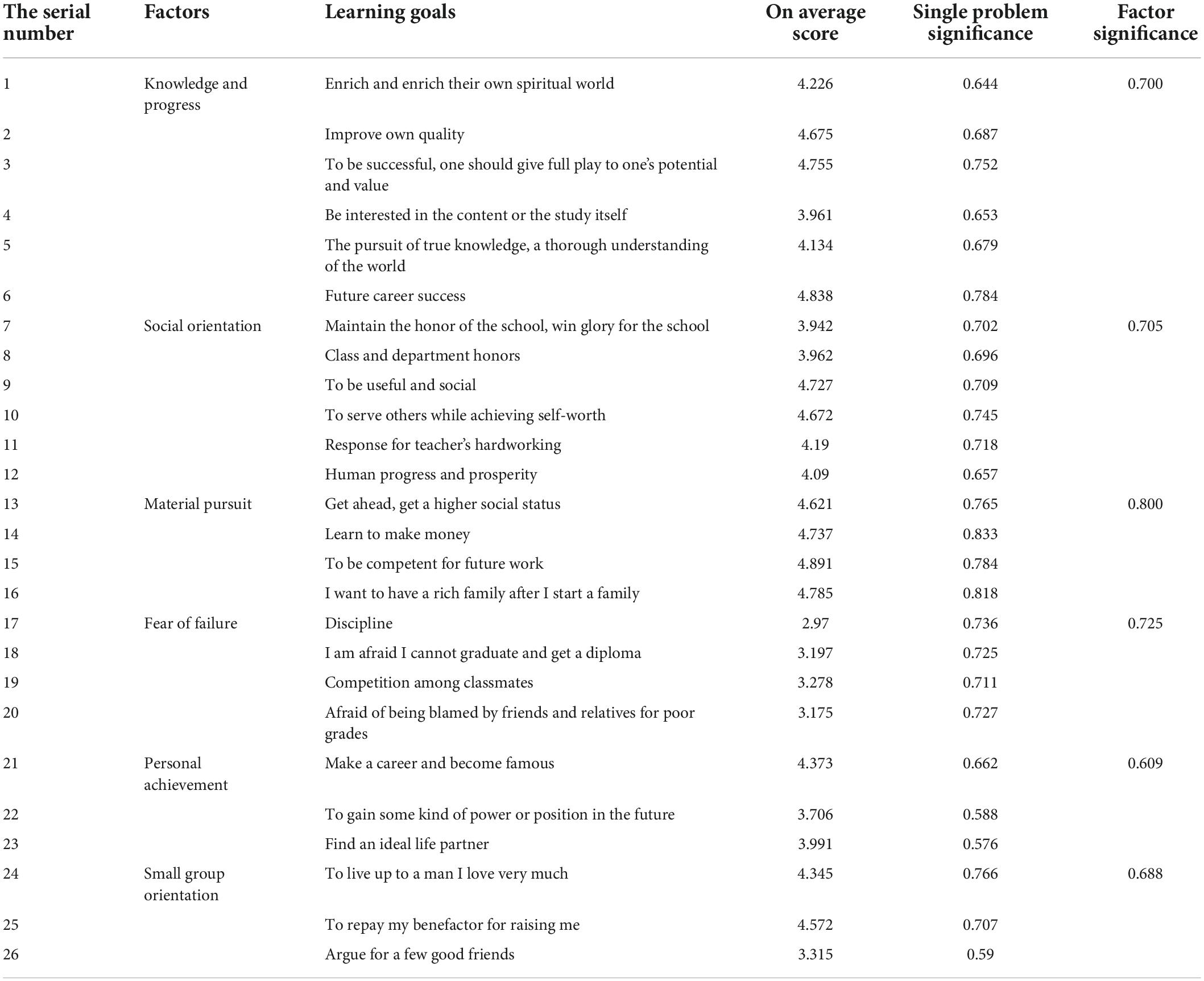
Table 1. Mean scores of the six motivations of the respondents and their significance in learning motivation.
Difference analysis of learning motivation
The control variable method was used to analyze the differences in gender, region, being only child or not, and discipline among the components of learning motivation. The Table 2 shows the significance of learning motivation among students between gender, region, and only child or not. The gender had a significant impact on personal achievement (P = 0.001 < 0.05), and the only child or not had an obvious effect on material pursuit (P = 0.004 < 0.05), while other factors had no obvious difference in gender, regional, and only child or not (P > 0.05). Learning motivation is affected by gender and whether or not a student is an only child.
Correlation analysis of the influence of various factors of learning motivation on academic performance
As can be seen in Figure 2, the students of different majors such as metallurgy, mechanical and electrical engineering, and architecture have significant differences in pursuit of knowledge and progress (P = 0.0003 < 0.05) and fear of failure (P = 0.0031 < 0.05), while there are no significant changes in social orientation, material pursuit, personal achievement, and small group orientation. As can be seen in Figure 3, students from the college of metallurgy and mechanical and electrical engineering and those from the college of arts showed significant differences in intellectual advancement (P = 0 < 0.05), social orientation (P = 0 < 0.05), and small-group orientation (P = 0.001 < 0.05) but no obvious differences in fear of failure and personal achievement.
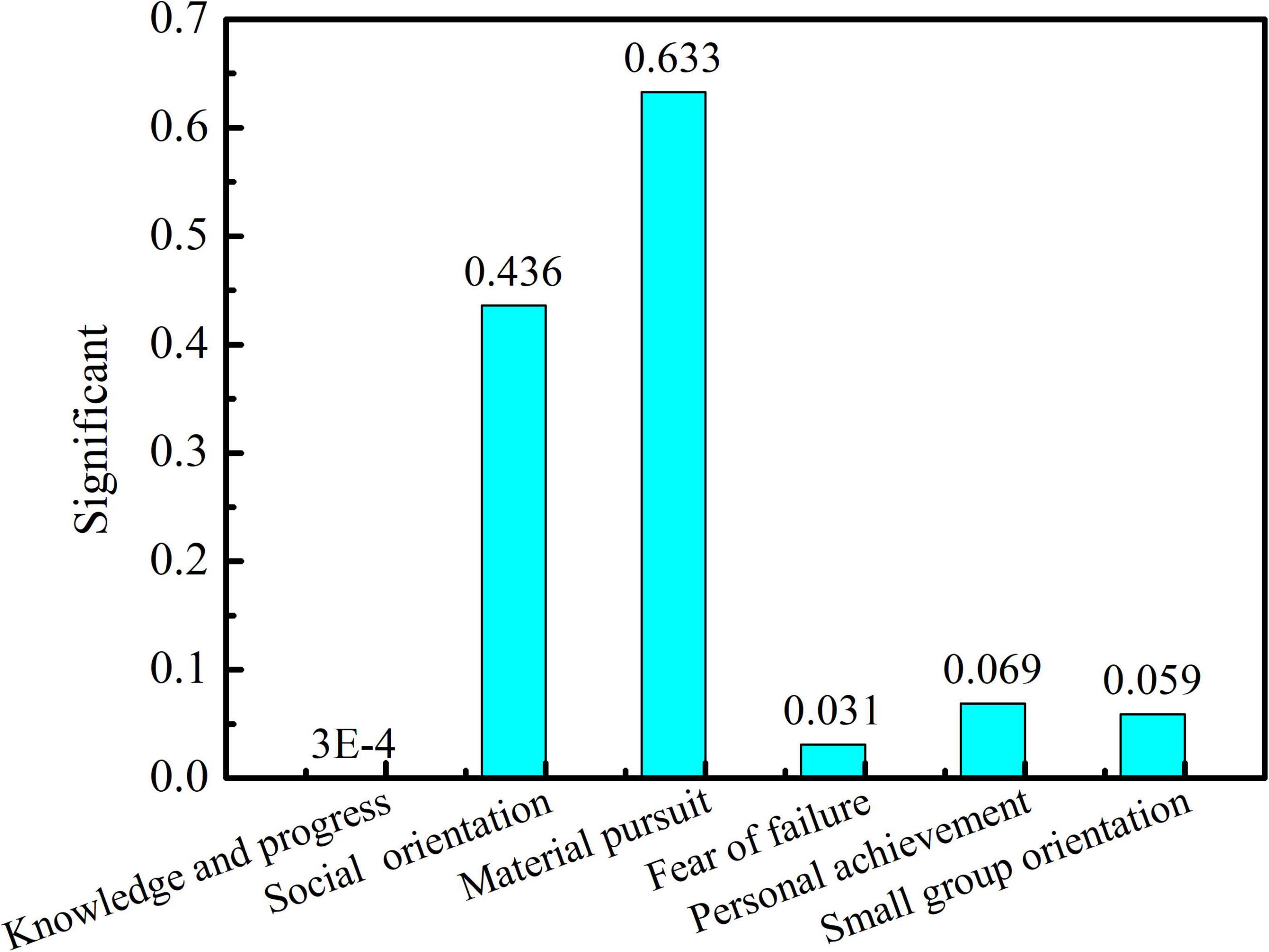
Figure 2. Significance of students’ learning motivation in college of metallurgical engineering, college of mechanical and electrical engineering, and architecture college of Xi’an.
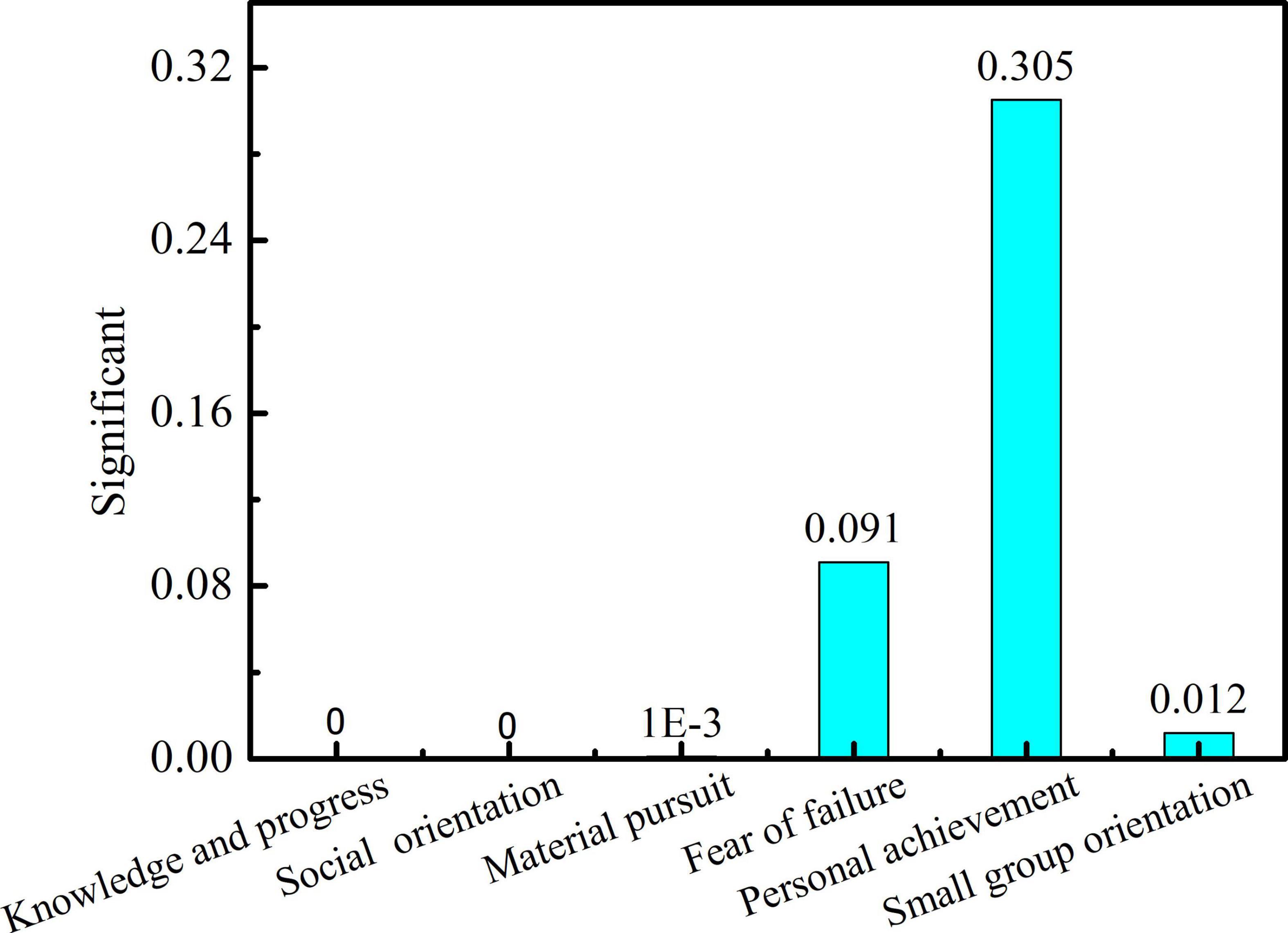
Figure 3. Significance of students’ learning motivation in college of metallurgical engineering, college of mechanical and electrical engineering, and college of art. Table 2 significance of learning motivation in gender, region, and only child or not.
Discussion
Overall evaluation of college students’ learning motivation
From the data analysis in Table 1, it can be seen that the correlation coefficients of various influencing factors of learning motivation are material pursuit, fear of failure, social orientation, knowledge pursuit and progress, small group orientation, and personal achievement from the top to the bottom.
Compared with the ranking of learning motivation of ordinary students, the ranking of material pursuit is basically consistent with the survey results (Xu, 2015). It is worth noting that the results of fear of failure in freshmen’s learning motivation were increased from the sixth place to the second place compared with the previous survey results (Xu, 2015), while the ranking of the other influencing factors of learning motivation did not change that much (Liu et al., 2005; Cheng, 2019). The above results show that the college students generally believe that the main purpose of going to college is to be able to satisfy their material life in the future, and that “to find a good job in the future” and “to have a rich family” are the expectations of the students.
However, fear of failure is rising because at the beginning of the semester, the students have high enthusiasm and strong sense of competition, and strictly abide by the school system, but such a motivation will gradually weaken later, and the fear of failure has no sustainable effect on learning motivation (Du, 2008). Furthermore, instead of being completely immersed in the passive learning of material pursuit and fear of failure, freshmen can show their determination to be a useful person and realize their own value. Compared with the personal achievement, social orientation has a greater impact on students’ learning motivation. This means that students are willing to work hard to maintain the honor of the school, college and class, and to become a person beneficial to society. However, we should also be aware that current college freshmen show insufficient motivation to pursue knowledge and progress, which is manifested by the lack of interest in improving their quality, learning content, and motivation to pursue true knowledge, etc., and that they still look forward to having a successful career.
Analysis on the difference in freshmen’s learning motivation
As can be seen in Table 2, the learning motivation of the freshmen showed significant differences in gender and whether they are an only child or not, but the differences were not significant in region. Specifically, the male and female students show significant differences in personal achievements, and their motivations for becoming famous and seeking power, status, and ideal lifelong partners are obviously different. However, the male students have a significantly higher desire for personal achievements than the female students. This result is similar with previous research, which pointed out that female students have learning motivations different from those of male students (Chang et al., 2020).
Although the learning motivation of college freshmen is not obviously different in regions, and the learning motivation of rural students in social orientation, material pursuit, personal achievement, and small group orientation is higher than that of urban students. Maybe it is because students in rural areas are at a resource disadvantage. After entering universities, rural students show a strong desire to learn and strive for honor or material security for themselves and the collective through their own efforts (Oudeyer et al., 2016; Qi and Zheng, 2010). Urban students, on the other hand, prefer to improve their personal quality and achieve career success.
In Figures 2, 3, it can be seen that significant differences between engineering students (metallurgy and mechanical and electrical) and art-related subjects (architecture and art) are reflected in the orientation of seeking knowledge. This may be due to differences in disciplines and students’ training modes. The engineering students are good at theoretical subjects but lack thinking skills (Kuo et al., 2021). However, the students majoring in arts need to study independently or cooperatively, and they need to pursue their own potential in learning, thus stimulating creativity. Moreover, the proportion of college students majoring in art in urban areas is larger than that of students taking other majors. Most students are pampered by their parents since childhood, and their material needs can be basically met. Therefore, the art students have a relatively less desire for material pursuit, which is different from students majoring in science and engineering.
Measures to improve learning motivation
The results above show students of different genders, regions, and disciplines being analyzed. According to the group characteristics of the students, ideological education is conducted in a personalized and scientific way to promote the better development of learning attitude (Campos-Mesa et al., 2019). For example, students’ learning motivation mainly focuses on material pursuit; as a result, schools, society, and families should guide students to avoid “money worship,” and at the same time give appropriate material rewards to improve students’ self-confidence, increase sense of security in learning, and maintain students’ enthusiasm. Besides, practical activities such as engineering experiments and social practice can also promote change in students’ learning motivation (Kuo et al., 2021; NaderAl-Osaimi and Fawaz, 2022).
Conclusion
Differences in the learning motivation of college freshmen in Northwest China were investigated in this article. The main conclusions are as follows:
(1) The correlation coefficients of various influencing factors of learning motivation are material pursuit, fear of failure, social orientation, knowledge pursuit and progress, small group orientation, and personal achievement from the top to the bottom.
(2) The learning motivation of the freshmen showed significant differences in gender and whether they are an only child or not, but the differences were not significant in region. Boys’ desire to achieve results in personal achievement is obviously higher than that of girls’, and girls’ pursuit of knowledge is stronger than that of boys.
(3) Significant differences between engineering students and those taking up art-related subjects are reflected in the orientation of seeking knowledge. Students majoring in science and engineering are lower than students majoring in art in seeking knowledge, and students majoring in art have lower desire for material things than students majoring in science and engineering.
(4) Rural students have a higher learning motivation in social orientation, material pursuit, personal achievement, and small group orientation than urban students.
Data availability statement
The raw data supporting the conclusions of this article will be made available by the authors, without undue reservation.
Ethics statement
The studies involving human participants were reviewed and approved by the Ethics Committee of Xi’an University of Architecture and Technology. The patients/participants provided their written informed consent to participate in this study.
Author contributions
KQ drafted the manuscript, designed the questionnaires, and proposed the idea. PG translated and revised the manuscript. RX collected the data, preformed the statistical analysis, and designed the study. BL and XC contributed to the revision of the manuscript and funded the investigation. All authors have read and agreed to the final version of the manuscript.
Funding
We are grateful for the funding from the Special Project of Shaanxi Provincial Department of Education (Z20190495) and the sponsorship from the Science Foundation of Xi’an University of Architecture and Technology (No. FD19007), and the Ideological and Political Education Research Association of Xi’an University of Architectural Science and Technology 2019 Annual Conference (No. SZ1923).
Conflict of interest
The authors declare that the research was conducted in the absence of any commercial or financial relationships that could be construed as a potential conflict of interest.
Publisher’s note
All claims expressed in this article are solely those of the authors and do not necessarily represent those of their affiliated organizations, or those of the publisher, the editors and the reviewers. Any product that may be evaluated in this article, or claim that may be made by its manufacturer, is not guaranteed or endorsed by the publisher.
References
Campos-Mesa, M., González-Campos, G., and Castañeda-Vázquez, C. (2019). Analysis of the motivation of higher education students participating in a formative assessment experience. Sports Res. Trends 8, 53–58. doi: 10.6018/sportk.401111
Cao, C., and Meng, Q. (2020). Exploring personality traits as predictors of English achievement and global competence among Chinese university students: English learning motivation as the moderator. Learn. Individ. Differ. 7:101814. doi: 10.1016/j.lindif.2019.101814
Chang, C. M., Chou, Y. H., Hsieh, H. H., and Huange, C. K. (2020). The effect of participation motivations on interpersonal relationships and learning achievement of female college students in sports club: Moderating role of club involvement. Int. J. Environ. Res. Public Health 17:6514. doi: 10.3390/ijerph17186514
Cheng, Q. Q. (2019). Analysis on the influence of family background on college students’ learning engagement. ModernCommun 3, 126–127.
Du, Y. F. (2008). Investigation and analysis on the current situation of college students’ learning motivation. Materials 10, 188–190. doi: 10.1016/j.physio.2012.07.004
Durdy, M., Mukhatov, M., and Izzat, K. (2020). The influence of family socio-economic, learning motivation and learning independency on student learning outcomes. J. Educ. Verkenn. 1:48173. doi: 10.48173/jev.v1i2.56
Gobena, G. A. (2018). Family socio-economic status effect on students’ academic achievement at college of education and behavioral sciences, Haramaya University, Eastern Ethiopia. J. Teach. Educ. Educ. 7, 207–222.
Hu, X. Y., and McGeown, S. (2020). Exploring the relationship between foreign language motivation and achievement among primary school students learning English in China. System 89:102199. doi: 10.1016/j.system.2020.102199
Huang, X. T., and Zheng, Y. (1999). Psychological characteristics and education of contemporary Chinese college students. Shanghai: Shanghai education press.
Kormos, J., and Kiddle, T. (2013). The role of socio-economic factors in motivation to learn English as a foreign language: The case of Chile. System 41, 399–412. doi: 10.1016/j.system.2013.03.006
Kuo, H. C., Yang, C. Y. T., Chen, J. S., Hou, T. W., and Ho, M. T. (2021). The impact of design thinking PBL robot course on college students’ learning motivation and creative thinking. IEEE Trans. Educ. 65, 124–131. doi: 10.1109/TE.2021.3098295
Liu, B. L., Qiao, K., and Lu, Y. F. (2021). The relationship between perceived stress, state-trait anxiety, and sleep quality among university graduates in china during the covid-19 pandemic. Front. Psychol. 12:664780. doi: 10.3389/fpsyg.2021.664780
Liu, C. S., Zhang, Y. M., and Zhang, H. (2005). Gender, grade and discipline differences in college students’ learning motivation. China Clin. Rehabil. 20, 96–98.
NaderAl-Osaimi, D., and Fawaz, M. (2022). Nursing students’ perceptions on motivation strategies to enhance academic achievement through blended learning: A qualitative study. Heliyon 8:09818. doi: 10.1016/j.heliyon.2022.e09818
Octaviany, I. N., and Usman, O. (2021). The influence of the family environment, learning motivation, and interest in learning on student learning discipline, 1–15. Available online at: http://dx.doi.org/10.2139/ssrn.3768848 (accessed January 18, 2021).
Oudeyer, P. Y., Gottlieb, J., and Lopes, M. (2016). Intrinsic motivation, curiosity, and learning: Theory and applications in educational technologies. Motivation 229, 257–284. doi: 10.1016/bs.pbr.2016.05.005
Qi, W. S., and Zheng, P. G. (2010). Research on characteristics of college students majoring in art. Educ. Place 1, 189–190.
Ryan, R. M., and Deci, E. L. (2002). “Overview of self-determination theory: An organismic dialectical perspective,” in Handbook of self-determination research, eds E. L. Deci and R. M. Ryan (Rochester, NY: University of Rochester), 3–33. doi: 10.1111/bjhp.12054
Tranquillo, J., and Stecker, M. (2016). Using intrinsic and extrinsic motivation in continuing professional education. Surg. Neurol. Int. 7, 197–199. doi: 10.4103/2152-7806.179231
Keywords: college freshmen, learning motivation, personal achievement, material pursuit, gender
Citation: Qiao K, Xu R, Liu B, Chen X and Gu P (2022) The differences in learning motivation of college freshmen in Northwest China. Front. Psychol. 13:997137. doi: 10.3389/fpsyg.2022.997137
Received: 18 July 2022; Accepted: 14 September 2022;
Published: 11 October 2022.
Edited by:
María Luisa Zagalaz-Sánchez, University of Jaén, SpainReviewed by:
Óscar Del Castillo Andrés, University of Seville, SpainMaría Del Carmen Campos Mesa, University of Seville, Spain
Copyright © 2022 Qiao, Xu, Liu, Chen and Gu. This is an open-access article distributed under the terms of the Creative Commons Attribution License (CC BY). The use, distribution or reproduction in other forums is permitted, provided the original author(s) and the copyright owner(s) are credited and that the original publication in this journal is cited, in accordance with accepted academic practice. No use, distribution or reproduction is permitted which does not comply with these terms.
*Correspondence: Ke Qiao, cWlhb2tlXzIwMjBAMTI2LmNvbQ==; Xiangyang Chen, NTI4OTUwMThAcXEuY29t
 Ke Qiao
Ke Qiao Ruizhao Xu
Ruizhao Xu Bailong Liu
Bailong Liu